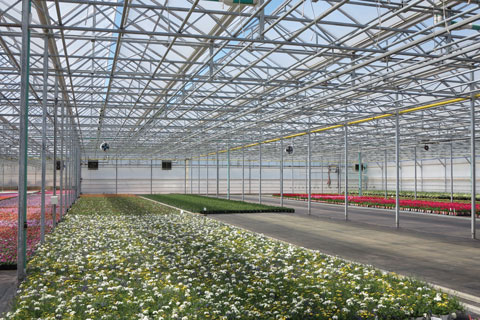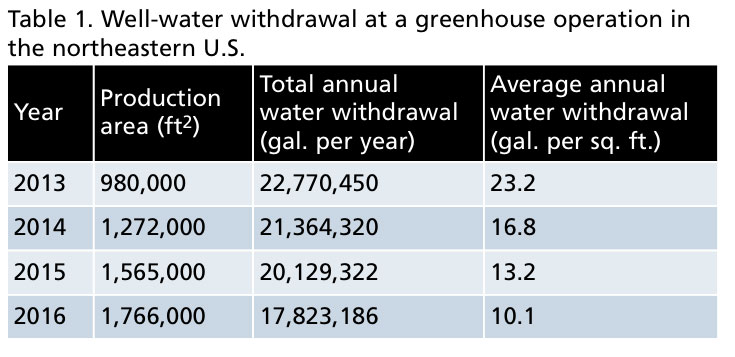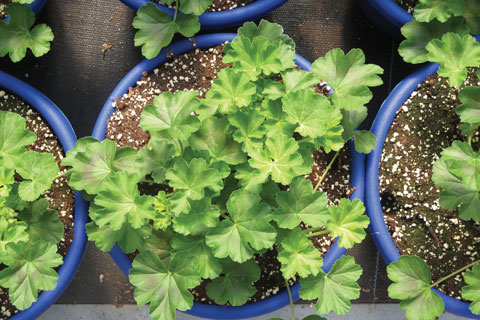11/1/2018
Save Water, Save Money
Rosa E. Raudales & Ryan Dickson
In locations where water is limited or the price of water is high, the value of conserving and recirculating nutrient solutions are important factors in the irrigation system design. In this article, we present two case studies of the benefits of recirculating nutrient solutions in greenhouses producing ornamentals in containers.

Save water: Grow more with fewer resources
The greenhouse operation: A 980,000 sq. ft. greenhouse operation extracted an average of 23M gal. of well-water per year for irrigation purposes, equivalent to an annual average of 23.2 gal. per sq. ft. greenhouse. Four deep-wells were the only water source. All the incoming water was fertilized with water-soluble fertilizers and then distributed to concrete flood floors via subirrigation or as overhead irrigation with booms.
Figure 1. Greenhouse with strict sanitation program.
The problem: The grower had enough market demand and land to expand the growing area, but local regulations imposed daily water-withdrawal limits. The grower was also concerned about not increasing nutrient runoff outside of the property. The grower expanded the production area for three consecutive years from 980,000 sq. ft. in 2013 to 1.3M sq. ft. in 2014, 1.6M sq. ft. in 2015, and finally 1.8M sq. ft. in 2016. At this rate of expansion and maintaining the same water use (23.2 gal./sq. ft./year), the grower would have needed 29.5M, 36.3M and 40.9M gal. of water per year, respectively. The problem was how to increase the production area with a limited amount of water resources.
The solution and benefits: The grower designed an irrigation system in which they captured the nutrient solution from flood floors and recirculated it to other sections of the greenhouse. The irrigation system design included a series of filters to remove organic debris, an activated-carbon filtration system to remove chemical residues and a sanitizer to reduce the risk of plant pathogens and biofilm. The operation implemented strict sanitizing programs (Figure 1) and proper watering (Figure 2) as a strategy to reduce water use and prevent root diseases.
 In a three-year period, this greenhouse operation almost doubled the growing space while reducing the amount of fresh water extracted from the wells by 4.9M gal. per year (Table 1). The efficiency of water use reduced from 23.2 to 10.1 gal. per sq. ft. per year.
In a three-year period, this greenhouse operation almost doubled the growing space while reducing the amount of fresh water extracted from the wells by 4.9M gal. per year (Table 1). The efficiency of water use reduced from 23.2 to 10.1 gal. per sq. ft. per year.
In this case study, recirculating nutrient solutions represented a major opportunity to expand the operation in the same location. This case study also illustrates that thoughtful design paired with proper training can be the tools to increase production with fewer resources.
Save money: Don’t pay twice for the same product
The greenhouse operation: A greenhouse operation with 600,000 sq. ft. growing area used an average of 41.4M gal. per year of water for irrigation. The main water source was municipal water. All the incoming water was chlorinated, fertilized with water-soluble fertilizer and then distributed to concrete flood floors either via subirrigation or as overhead irrigation with booms.
The problem: The main water source for the operation was municipal water, costing $3.94 per 1,000 gal. The additional costs to chlorinate and add water-soluble fertilizer to the nutrient solution were $0.12 and $1.84 per 1,000 gal., respectively. The total cost of incoming nutrient solution equaled $5.89 per 1,000 gal. If the grower were to purchase 41.4M gal. of water per year, the total cost of irrigation water would equal $243,867 per year ($4,968 for chlorination, $76,183 for fertilizer and $163,130 for municipal water supply). The problem was therefore to reduce this high cost of water and nutrient supply.
The solution and benefits: The greenhouse had sufficient storage capacity to capture and recirculate water coming from the flood floors. In 2012, the grower purchased, chlorinated and fertilized 8.6M gal. of water and recirculated the remaining requirement of 32.8M gal. The cost of the 8.6M gal. of fresh, non-recirculated water was $50,675 per year for water supply, chlorination and fertilization.
The large volume (32.8M) of return water from the flood floors was captured in a return tank and then filtered for reuse. Filtration was only applied to recirculated nutrient solution and incoming fresh municipal water wasn’t filtered. Water from one growing area (17.6M gal.) was filtered with synthetic fiber rolls. Filtration cost for the synthetic fiber filter was $0.33 per 1,000 gal., resulting in an annual cost of $5,808.
 Figure 2. Geranium plants allowed to dry before irrigation to avoid water overuse and root diseases.
Figure 2. Geranium plants allowed to dry before irrigation to avoid water overuse and root diseases.
An additional 15.2M gal. was filtered with a vibrating screen at a cost of $0.17 per 1,000 gal. and an annual total of $2,584. Total annual cost of the system therefore equaled $8,392 for both filter types. The cost of fresh nutrient solution ($50,675) plus filtration ($8,392) with the recirculating system equaled $59,067 per year, compared with the cost of $243,867 without recirculation.
This case study exemplifies the economic benefits of recirculating water, particularly when using expensive water resources and water-soluble fertilizers. Recirculation is a standard practice in greenhouses that use subirrigation because of the high volume of return water. Approximately 21% of the nutrient solution on average was absorbed by growing medium with the remaining 79% being collected in the return tank. The operation reused 32.8M gal. per year. If the company were to pay for this volume of water and fertilizer at $5.89 per 100 gal., it would cost an additional $193,192 per year.
We didn’t calculate the entire cost of recirculation in these case studies, which would be a much more complex calculation because of construction costs of floors, drainage, tanks, pumps and computer controls. The management in both operations emphasized training of employees on watering practices, overall sanitation, humidity control and plant health management, which proved effective at improving plant health.
Growers can be reluctant to recirculate nutrient solutions because they fear the risks of spreading plant pathogens or undesired chemicals contaminants. The risks are real, but manageable. Proper water treatment design is the solution to that problem. You can start by checking out cleanwater3.org.
Growers who proactively capture and reuse irrigation runoff are better prepared to respond to external pressures, such as regulation that enforces remediation of chemical residues or maximum water use or less water availability. GT
Rosa Raudales (rosa@uconn.edu) is an assistant professor in plant science at the University of Connecticut. Ryan Dickson is an assistant professor in horticulture at the University of Arkansas.